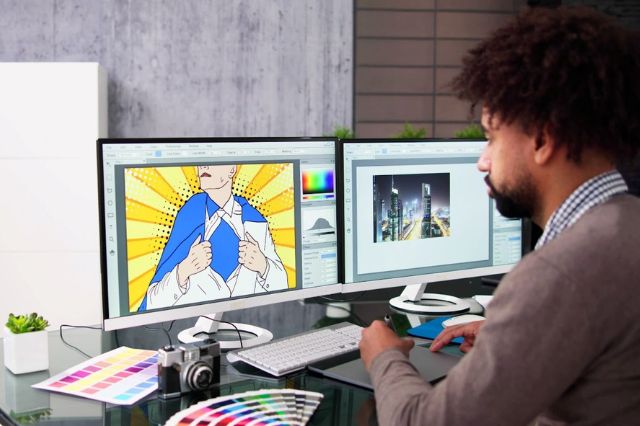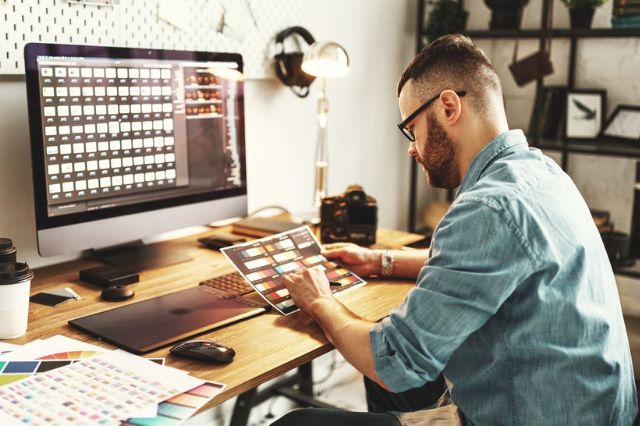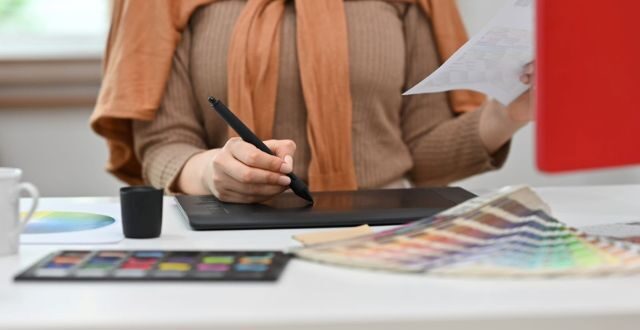Graphic design allows creators to deliver visual messages and express their creative vision through experiments with typography, colors, and other elements of contemporary and retro graphic design styles. This artistic career seems appealing to many, but is also difficult to approach.
To take your first steps in graphic design and create compelling compositions, read further. This article explains graphic design basics and provides practical tips on design creation.
What exactly is graphic design?
Graphic design is the process of creating print and digital format visuals that look captivating, grab attention, and deliver specific messages to a target audience. It plays a crucial role in branding, marketing, communication, and other areas that require high-quality visual content.
Graphic design includes designing logos, promotional materials, websites, publications, and digital interfaces, contributing to effective communication and establishing a distinct visual identity.
Key aspects of efficient design
The key to a good graphic design is balancing creativity and functionality. Here are some essential elements that make a design efficient:
- Clarity. A good design delivers its message clearly and effectively. It should be easy to understand the main idea at first glance, and the target audience should be able to perceive it correctly. For instance, a well-crafted infographic must convey precise information, making it accessible and easily understandable to the viewer.
- Visual hierarchy. The viewer must be able to instantly recognize and focus on the most important elements, such as a brand’s name or a call-to-action. This intentional arrangement guides the attention, creating a straightforward and organized visual path that enhances the design’s overall effectiveness.
- Typography. The chosen fonts must align with the intended message. For instance, playful fonts are generally suitable for a children’s design, while a classic font is more suitable for a formal project. The selected typography must also boost readability, ensuring your audience can easily comprehend the presented information.
- Color. Considering the meaning of different colors in design, your chosen palette should support the intended message and create a desired emotional impact. The overall color scheme shouldn’t strain the eyes, creating a visually pleasant and cohesive design.
- Consistency. Maintaining a uniform style and using consistent design elements throughout all materials helps improve recognition. This approach reinforces brand identity, making it easier for the audience to associate and remember key project elements.
5 different types of graphic design

Graphic design covers a wide range of areas. As a professional, you can build skills in all of these areas, stick to several of them, or pick one that seems most appealing and hone your expertise in it. Read further to learn what types of graphic design exist on the market.
Visual identity and branding
This type of design is focused on creating a unique and consistent visual identity for companies and brands. This includes logo design, brand identity, and brand guidelines. Visual identity aims to create a strong and recognizable brand image that fosters trust and connects with the target audience.
Print design
Print design was invented in the early eras, but evolved over time and remains an important part of the industry. It is all about creating printed materials and visuals that will be used in the physical world: posters, flyers, brochures, business cards, packaging, and magazines. Print designers must consider layout, typography, color, and paper quality to ensure the result is visually appealing and effectively conveys its intended message.
Social media design
As social media platforms rise and develop, more companies and brands look for designers who can create appealing materials for them to engage with their online audience. This area involves creating visuals in various types of graphic design styles, including illustrations, infographics, and interactive content. These materials are specifically tailored for social media posts, stories, and profiles. Efficient social media design includes attention-grabbing images, compelling texts, and the consistent application of a brand’s visual identity.
Typography
Graphic designers choose fonts, adjust spacing, and apply formatting to text in various projects. Typography helps convey the desired tone and enhances the overall aesthetics of a design. It’s an essential element for ensuring that text is readable and harmonizes with the overall visual message.
Motion design
Motion is one of the most recently developed types of design. It is all about creating moving graphics and animations to engage and inform viewers. Motion graphics are used in videos, presentations, websites, apps, and other digital products. Designers in this niche use their skills to bring static visuals to life and enhance storytelling and user experience through animation, transitions, and dynamic visuals.
How to make a good graphic design

The ability to create solid and appealing graphics is not a talent but a skill. And just like any other skill, it can be built and improved with time and practice. The following tips can help you enhance your visuals even if you don’t have much experience in graphic design yet.
Whitespace
Don’t be afraid to use whitespace—empty or blank spaces—effectively in your design. It can help improve readability, highlight important elements, and create a sense of elegance and simplicity.
Balance
Aim for balance in your design by distributing visual elements evenly. Avoid lopsided layouts or ones that are overly cluttered with details. Balance creates a pleasing visual flow and harmony.
Originality
While it’s natural to draw inspiration from others, strive for originality in your design. Show your unique style or perspective in your work to make it stand out.
Proportion
Pay attention to the size and scale of various elements in your design. Ensure that elements are proportionate to each other and that nothing appears too large or too small in relation to the overall composition.
Adaptability
Consider how your design will appear in various formats and on different devices. Ensure it’s adaptable and retains its quality and impact, whether viewed on a computer screen, a mobile device, or in print.
To sum up
Graphic design is all about creating print and digital visuals that help shape brands, connect them with their target audiences, and deliver various messages. There are different types of graphic design, starting from typography and ending with social media and motion. To start building your career in graphic design, pick the type you like most and start practicing with our tips in mind.
 khamush.com Lifestyle | Motivation | Poems
khamush.com Lifestyle | Motivation | Poems



